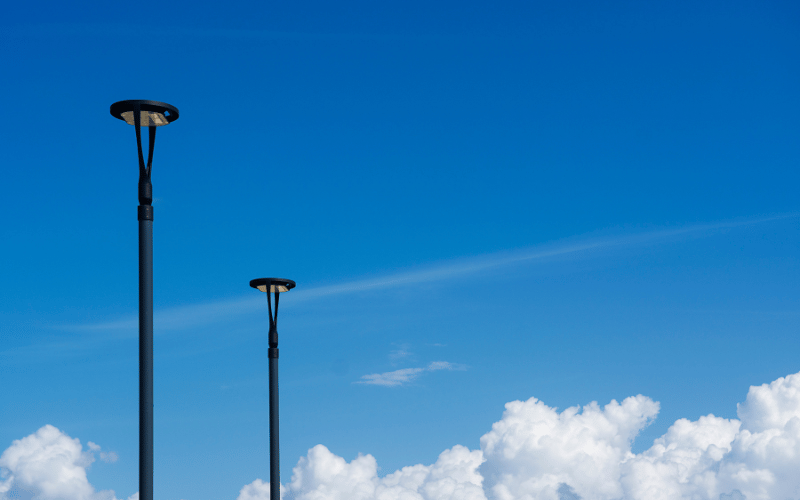Choosing the right streetlight height is crucial in ensuring safety, optimizing energy efficiency, and managing costs effectively. The height of a streetlight directly impacts how well it illuminates roads, sidewalks, and public spaces, influencing visibility for drivers, pedestrians, and cyclists. A poorly chosen height can lead to issues like glare, dark spots, or excessive energy consumption, all of which compromise safety and efficiency.
City planners often face significant challenges when designing street lighting systems. Glare from overly tall fixtures can blind drivers, while uneven lighting from poorly spaced or low-mounted lights creates unsafe conditions. Maintenance costs also rise when fixtures are difficult to access or require frequent adjustments due to improper placement. Balancing these factors while adhering to budget constraints and local regulations adds another layer of complexity to the decision-making process.
This article aims to simplify the process by offering a comprehensive guide to determining the ideal streetlight height. By considering road types, traffic patterns, and specific usage scenarios, you’ll gain the insights needed to design a lighting system that enhances safety, minimizes energy waste, and reduces long-term costs. Whether you’re planning for residential streets, highways, or commercial areas, this guide will help you make informed decisions that benefit both the community and the environment.
Table of Contents
ToggleWhat’s the Normal Height of a Streetlight Pole?
The height of a streetlight pole is not arbitrary—it’s a carefully calculated factor that directly impacts safety, visibility, and energy efficiency. Over the years, I’ve worked with countless projects where selecting the right pole height made the difference between a well-lit, functional roadway and one plagued by glare, dark spots, or wasted energy. Let’s break down the three standard height ranges and how they align with specific traffic and road conditions.
4 – 6 Meters: Rural and Village Lanes
For rural roads and village lanes, streetlight poles typically range between 4 and 6 meters in height. These areas often have lower traffic volumes and slower vehicle speeds, so the lighting requirements are less demanding. Shorter poles ensure that the light is concentrated closer to the ground, providing adequate visibility for pedestrians, cyclists, and occasional vehicles.
In my experience, this height range works best when paired with fixtures that have a narrow beam angle, focusing the light on pathways and minimizing spillover into surrounding areas. This targeted approach not only improves visibility but also reduces energy consumption, as fewer lumens are needed to achieve the desired brightness. Additionally, shorter poles are easier to maintain, which is a significant advantage in rural areas where access to specialized equipment may be limited.

8 – 10 Meters: Busy Urban Roads
Urban roads with moderate to heavy traffic require streetlight poles in the 8 to 10-meter range. This height strikes a balance between providing broad, even coverage and minimizing glare for drivers and pedestrians. On busy streets, proper pole height ensures that the light reaches across multiple lanes without creating harsh shadows or over-illuminating certain areas.
For urban settings, I often recommend pairing these poles with high-efficiency LED fixtures that offer wide beam angles. This combination ensures uniform lighting across sidewalks, bike lanes, and roadways, enhancing safety for all users. Additionally, the slightly elevated height helps reduce light pollution by directing the beam downward, which is especially important in densely populated areas. Properly spaced poles at this height can also reduce the total number of fixtures needed, lowering both installation and energy costs.
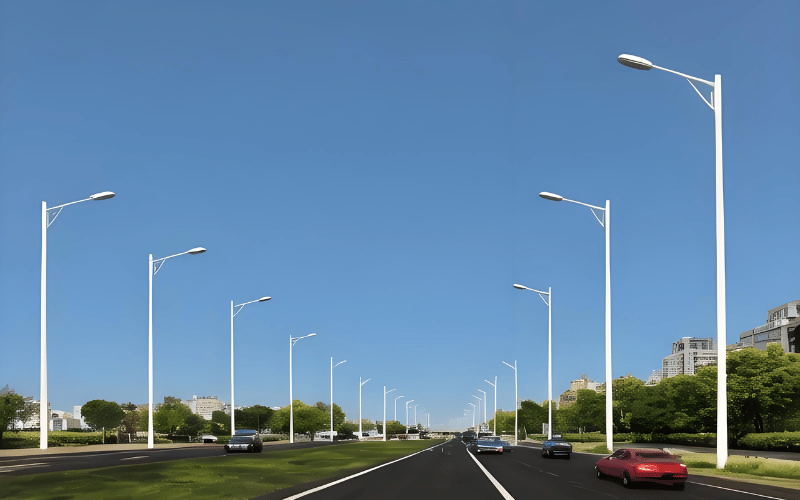
10 – 12 Meters: High-Speed Highways
High-speed highways demand taller poles, typically ranging from 10 to 12 meters. At these speeds, drivers need clear, consistent visibility over long distances to react to potential hazards. Taller poles allow for wider light distribution, ensuring that the road ahead is well-lit without creating distracting glare.
In highway projects I’ve worked on, the key to success lies in using fixtures with precise optics that focus the light on the roadway while minimizing spillover into adjacent areas. This not only improves safety but also reduces energy waste. Taller poles also help reduce the number of fixtures required to cover long stretches of road, which can significantly lower both upfront and maintenance costs. However, it’s crucial to ensure that the poles are sturdy enough to withstand high wind loads, especially in open areas.
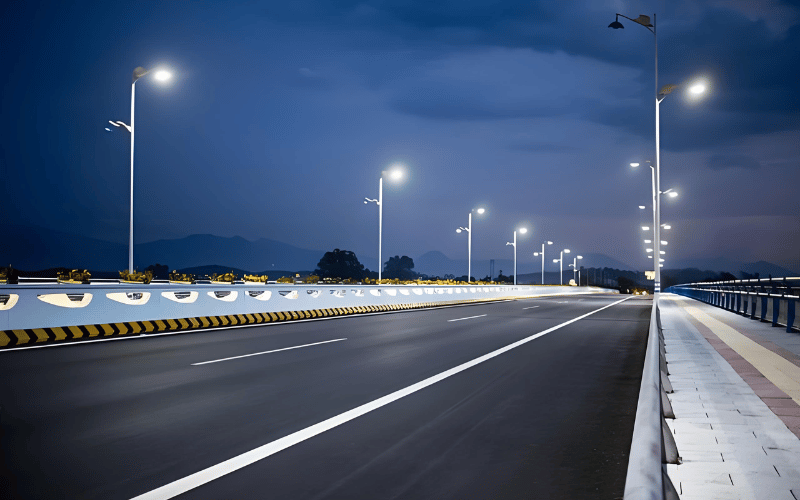
Why Matching Pole Height to Traffic Type Matters
Choosing the right pole height is about more than just aesthetics—it’s a critical factor in achieving efficient, effective lighting. When the pole height matches the traffic type and road conditions:
- Lighting Becomes Even: Proper height ensures that light is distributed uniformly, eliminating dark spots and reducing glare.
- Energy Costs Drop: Taller poles with optimized spacing can reduce the total number of fixtures needed, while shorter poles in low-traffic areas prevent over-lighting.
- Safety Improves: Drivers, pedestrians, and cyclists benefit from consistent visibility, reducing the risk of accidents.
By carefully considering the specific needs of each roadway, you can design a lighting system that not only meets safety standards but also delivers long-term value. Whether you’re illuminating a quiet village lane or a bustling highway, the right pole height is the foundation of a successful street lighting project.
Determining Pole Height for Different Road Types
Selecting the right pole height for streetlights is a critical decision that directly impacts safety, energy efficiency, and long-term costs. Over the years, I’ve worked on countless projects where tailoring pole height to the specific road type has delivered measurable benefits, from reduced glare to significant cost savings. Let’s explore how pole height varies across rural streets, urban main roads, and highways, and why these differences matter.
Rural Streetlights (4 – 6 m)
Why Low Poles Work Best
In rural and village lanes, where traffic is light and speeds are low, shorter poles ranging from 4 to 6 meters are ideal. These poles focus light closer to the ground, ensuring adequate visibility for pedestrians, cyclists, and occasional vehicles without creating unnecessary glare. Additionally, shorter poles are more cost-effective to install and maintain, making them a practical choice for budget-conscious municipalities.
I recall a rural solar lighting project in a small village where we installed 5-meter poles with 40W LED fixtures. By optimizing the pole height and spacing, we reduced the number of poles required by 15% compared to the initial plan. This not only saved on installation costs but also lowered energy consumption, resulting in annual savings of over $2,000 for the community.
Key Specifications
- LED Wattage: 30 – 50 W
- Typical Spacing: 18 – 22 m
- Battery and Solar Panel Recommendations: Use a 60 Ah lithium-ion battery paired with a 100W solar panel for consistent performance, even in cloudy conditions.
Table 1: Rural Pole Comparison
| Item | 4 m Pole | 5 m Pole | 6 m Pole |
|---|---|---|---|
| Steel weight (kg) | 29 | 34 | 40 |
| LED rating (W) | 30 | 40 | 50 |
| Typical spacing (m) | 18 | 20 | 22 |
| Energy use (kWh/year) | 64 | 82 | 98 |
Urban Main Roads (8 – 10 m)
Balancing Brightness, Reach, and Cost
For busy urban roads, medium-height poles between 8 and 10 meters provide the perfect balance of wide light coverage and cost efficiency. These poles ensure curb-to-curb illumination while minimizing glare for drivers and pedestrians. Additionally, their height reduces the frequency of maintenance, as they are less prone to wind damage compared to taller poles.
In one urban project, we reduced pole height from 10 meters to 9 meters to improve wind resistance and lower material costs. This adjustment saved the city $15,000 in upfront costs and reduced cleaning time per pole by 20%, streamlining maintenance operations.
Key Specifications
- LED Wattage: 100 – 200 W
- Typical Spacing: 26 – 30 m
- Optics: Type II or Type III lenses for uniform curb-to-curb coverage.
Table 2: Urban Pole Comparison
| Parameter | 8 m Pole | 9 m Pole | 10 m Pole |
|---|---|---|---|
| Optimal LED range (W) | 100 – 120 | 120 – 160 | 160 – 200 |
| Typical spacing (m) | 26 | 28 | 30 |
| Wind load @ 110 km/h (kN) | 0.6 | 0.7 | 0.85 |
| Cleaning time (min/pole) | 4 | 4 | 5 |
Highways (10 – 12 m)
When Safety Drives the Budget
High-speed highways demand taller poles, typically ranging from 10 to 12 meters, to ensure consistent visibility over long distances. Taller poles allow for wider light distribution, reducing the number of fixtures required per kilometer. This not only enhances safety for drivers but also lowers installation and maintenance costs over time.
I worked on a highway project where we optimized pole height and LED wattage to achieve maximum safety and efficiency. By using 11-meter poles with 280W LEDs, we reduced the total pole count by 10% compared to the original design. This adjustment saved $50,000 in upfront costs and shortened the payback period for the LED system to just 2.5 years compared to traditional HPS lights.
Key Specifications
- LED Wattage: 200 – 300 W
- Typical Spacing: 30 – 34 m
- Foundation Requirements: Use deep anchor cages and C35-grade concrete to ensure stability against high wind loads.
Table 3: Highway Pole Comparison
| Spec | 10 m Pole | 11 m Pole | 12 m Pole |
|---|---|---|---|
| LED power (W) | 200 – 240 | 240 – 280 | 260 – 300 |
| Beam width @ 0.5 cd/m² (m) | 34 | 36 | 38 |
| Pole count per km | 33 | 31 | 30 |
| Payback (LED vs HPS, yrs) | 2.4 | 2.5 | 2.6 |
By aligning pole height with road type and traffic conditions, you can achieve optimal lighting performance while minimizing costs and energy use. Whether you’re illuminating a quiet rural lane, a bustling urban street, or a high-speed highway, the right pole height ensures safety, efficiency, and long-term value.
Factors to Consider When Choosing Pole Height
Selecting the right pole height for streetlights is not a one-size-fits-all decision. It requires a deep understanding of the road’s purpose, environmental conditions, and long-term maintenance needs. Over the years, I’ve worked on countless projects where these factors played a pivotal role in designing effective and efficient lighting systems. Let’s break down the key considerations that should guide your decision-making process.
1. Traffic Type and Volume
The type and volume of traffic on a road are among the most critical factors in determining pole height and spacing. High-speed roads, such as highways, require taller poles (10–12 meters) to ensure that light is distributed evenly over long distances. This minimizes the number of poles needed while providing consistent visibility for drivers traveling at high speeds. For example, a 12-meter pole with a wide beam angle can illuminate a larger area, reducing the risk of dark spots that could lead to accidents.
On the other hand, low-traffic rural roads or residential streets benefit from shorter poles (4–6 meters). These poles focus light closer to the ground, improving visibility for pedestrians and cyclists without over-illuminating the area. In one rural project I managed, we used 5-meter poles spaced 20 meters apart to light a village lane. This setup provided sufficient brightness for safety while keeping costs low, as fewer poles and smaller solar panels were required.
Key Insight: Match pole height to traffic speed and density. Higher speeds demand taller poles for broader coverage, while lower speeds allow for shorter poles with more focused lighting.
2. Lighting Goals
Every lighting project has specific goals, whether it’s enhancing safety, reducing energy consumption, or creating a welcoming ambiance. Balancing brightness, glare, and energy efficiency is essential to achieving these objectives.
For example, urban roads with moderate traffic require medium-height poles (8–10 meters) to provide curb-to-curb illumination without creating glare that could distract drivers or pedestrians. Using LED fixtures with Type II or Type III optics ensures that light is distributed evenly across the road and sidewalks. In one urban project, we reduced glare by using 9-meter poles with 120W LEDs, which provided uniform lighting while minimizing light spill into nearby buildings.
In contrast, highways prioritize safety over ambiance. Taller poles with high-wattage LEDs (200–300W) ensure that drivers can see far ahead, even at high speeds. However, over-lighting can lead to glare and wasted energy, so it’s crucial to use fixtures with precise optics that focus light on the roadway.
Key Insight: Define your lighting goals early in the design process. Whether you’re prioritizing safety, efficiency, or aesthetics, the right pole height and fixture combination will help you achieve your objectives.
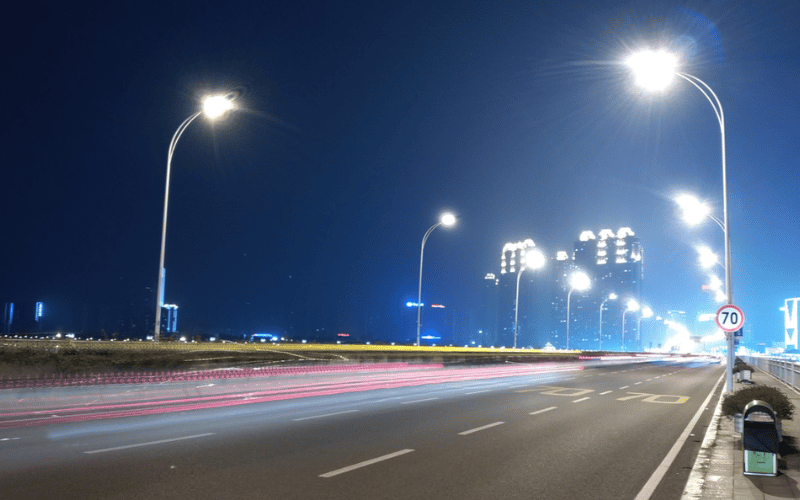
3. Environmental Conditions
Environmental factors such as wind loads, weather, and local regulations significantly influence pole height and design. Taller poles are more susceptible to wind loads, especially in open areas like highways or coastal regions. In one highway project, we used 11-meter poles with reinforced anchor cages and C35-grade concrete foundations to withstand wind speeds of up to 120 km/h. This ensured the poles remained stable and safe, even during storms.
Weather conditions also impact pole design. In areas with heavy snowfall, shorter poles are easier to maintain and less likely to be damaged by snow accumulation. Similarly, in regions with frequent rain or high humidity, corrosion-resistant materials like galvanized steel or aluminum are essential to extend the lifespan of the poles.
Local regulations may also dictate minimum lux levels or spacing requirements for specific road types. For example, some municipalities require a minimum lux level of 20 for urban roads, which may necessitate taller poles or closer spacing to meet the standard.
Key Insight: Consider environmental conditions and regulatory requirements when selecting pole height. Reinforce taller poles for wind resistance and choose materials that can withstand local weather conditions.
4. Maintenance and Costs
Pole height has a direct impact on maintenance requirements and long-term costs. Taller poles often require specialized equipment, such as bucket trucks, for cleaning and repairs, which increases maintenance expenses. For example, cleaning a 12-meter pole takes longer and costs more than cleaning a 6-meter pole, especially in areas with frequent dust or pollution.
Shorter poles, on the other hand, are easier and more cost-effective to maintain. In a rural project I worked on, we used 4-meter poles for pathway lighting. The local community could perform routine maintenance using basic tools, saving thousands of dollars in annual upkeep.
However, taller poles can reduce the total number of fixtures needed, which offsets some of the maintenance costs. For instance, a 10-meter pole with a wide beam angle can replace two shorter poles, reducing installation and material expenses.
Key Insight: Balance maintenance costs with installation efficiency. While taller poles may require more resources for upkeep, they can reduce the overall number of fixtures needed, leading to long-term savings.
By carefully considering traffic type, lighting goals, environmental conditions, and maintenance requirements, you can select the ideal pole height for your project. Each factor plays a crucial role in creating a lighting system that is safe, efficient, and cost-effective. With the right planning and expertise, you can design a solution that meets the unique needs of your community or roadway.
Innovations in Streetlight Design
The street lighting industry has undergone a remarkable transformation over the years, driven by advancements in technology and materials. As someone who has spent decades designing and implementing solar street lighting systems, I’ve seen firsthand how these innovations have improved efficiency, durability, and functionality. Let’s explore three key areas where modern streetlight design is making a significant impact: smart controls, hybrid poles, and advanced materials.
1. Smart Controls
The integration of smart controls has revolutionized how streetlights operate, making them more efficient and adaptable to real-world conditions. Features like dimming, motion sensors, and remote monitoring are no longer optional—they’re becoming essential components of modern lighting systems.
Dimming and Motion Sensors:
Smart dimming technology allows streetlights to adjust their brightness based on the time of night or the level of activity in the area. For example, a streetlight can operate at 50% brightness during off-peak hours and increase to full brightness when motion is detected. This not only conserves energy but also extends the lifespan of the LED fixtures and batteries.
I recently worked on a project for a residential community where we installed solar streetlights with motion sensors. The lights operated at a dimmed level of 30% brightness but instantly brightened to 100% when pedestrians or vehicles approached. This setup reduced energy consumption by 40% while maintaining safety and visibility for residents.
Remote Monitoring:
Remote monitoring systems allow city planners and maintenance teams to track the performance of streetlights in real time. Using IoT (Internet of Things) technology, these systems can detect issues like low battery levels, faulty LEDs, or damaged poles and send alerts to the maintenance team. This proactive approach minimizes downtime and reduces maintenance costs.
For example, in an urban project I managed, we implemented a remote monitoring system for 200 solar streetlights. The system flagged underperforming lights immediately, allowing the team to address issues before they became major problems. This reduced repair times by 50% and improved overall system reliability.
Key Insight: Smart controls not only enhance energy efficiency but also provide valuable data for optimizing streetlight performance. When planning a project, prioritize systems with dimming capabilities, motion sensors, and remote monitoring to maximize long-term benefits.
2. Hybrid Poles
Hybrid poles, which combine solar power with grid electricity, are becoming increasingly popular in urban areas and highways. These systems offer the best of both worlds: the sustainability of solar energy and the reliability of grid power.
How Hybrid Systems Work:
Hybrid poles use solar panels to generate energy during the day, which is stored in batteries for nighttime use. If the battery runs low due to extended cloudy weather or high energy demand, the system automatically switches to grid power. This ensures uninterrupted lighting, even in challenging conditions.
In a highway project I worked on, we installed hybrid poles with 300W LEDs to illuminate a 5-kilometer stretch. The solar panels provided 70% of the energy needed, while the grid served as a backup during peak traffic hours or overcast days. This setup reduced energy costs by 60% compared to a fully grid-powered system and ensured consistent lighting for high-speed vehicles.
Applications of Hybrid Poles:
- Highways: Hybrid systems are ideal for highways, where consistent lighting is critical for safety.
- Urban Areas: In cities, hybrid poles can reduce the strain on the grid while maintaining reliable lighting for busy streets and intersections.
- Disaster-Prone Regions: Hybrid systems provide a backup power source, ensuring lighting remains operational during grid outages caused by natural disasters.
Key Insight: Hybrid poles are a practical solution for areas with high energy demands or inconsistent sunlight. They offer a reliable, cost-effective way to ensure uninterrupted lighting while reducing dependence on the grid.
3. Advanced Materials
The materials used in streetlight poles have a significant impact on their durability, maintenance requirements, and overall lifespan. Modern poles are increasingly made from advanced materials like galvanized steel and powder-coated finishes, which offer superior performance in harsh environments.
Galvanized Steel:
Galvanized steel poles are coated with a layer of zinc, which protects them from rust and corrosion. This is especially important in coastal areas or regions with high humidity, where traditional steel poles would deteriorate quickly. In one coastal project I managed, we replaced rusted poles with galvanized steel ones. The new poles have remained corrosion-free for over a decade, significantly reducing maintenance costs.
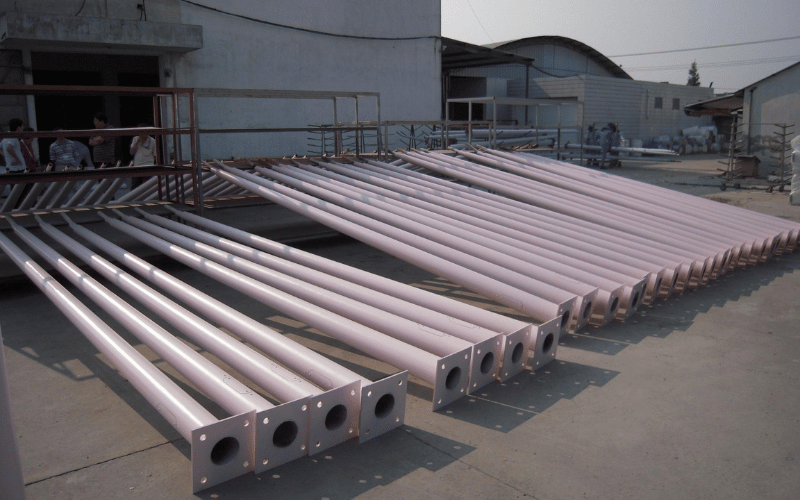
Powder-Coated Finishes:
Powder coating adds an additional layer of protection to poles, enhancing their resistance to UV rays, moisture, and physical wear. It also allows for customization, as poles can be powder-coated in various colors to match the aesthetic of the surrounding area. For example, in a city beautification project, we used powder-coated poles in a sleek black finish to complement the modern architecture of the area.
Benefits of Advanced Materials:
- Durability: Galvanized and powder-coated poles can withstand extreme weather conditions, from heavy rain to intense sunlight.
- Low Maintenance: These materials require minimal upkeep, reducing long-term maintenance costs.
- Aesthetic Appeal: Powder-coated finishes offer a polished look that enhances the visual appeal of urban and residential areas.
Key Insight: Investing in high-quality materials like galvanized steel and powder-coated finishes ensures that your streetlight poles remain durable and visually appealing for years to come. This is especially important for projects in harsh or high-visibility environments.
Innovations in streetlight design, from smart controls to hybrid poles and advanced materials, are transforming the way we illuminate our roads and public spaces. By leveraging these advancements, you can create lighting systems that are not only efficient and reliable but also tailored to the unique needs of your community or project. With the right approach, streetlights can do more than light the way—they can set a new standard for sustainability, safety, and design.
Frequently Asked Questions
Q: How does pole height affect light distribution and coverage?
A: Pole height directly impacts how light spreads across an area. Taller poles provide broader coverage, making them ideal for highways and wide roads. Shorter poles focus light on smaller areas, which works well for pathways or village lanes. Choosing the right height ensures even lighting without creating dark spots or glare.
Q: What are the key factors to consider when choosing streetlight pole height?
A: Consider traffic type, road width, and the purpose of the lighting. High-speed roads need taller poles for wider coverage, while low-traffic areas benefit from shorter poles. Environmental conditions, like wind loads, and maintenance requirements also play a crucial role in selecting the right height.
Q: How does wind load impact the design of taller streetlight poles?
A: Taller poles face greater wind resistance, especially in open areas or coastal regions. To ensure stability, use reinforced anchor cages and high-grade materials like galvanized steel. Proper design prevents poles from swaying or collapsing during strong winds.
Q: Can solar-powered streetlights work effectively on taller poles?
A: Yes, solar-powered streetlights can work on taller poles, but they require larger solar panels and higher-capacity batteries to maintain brightness. Properly designed systems with efficient LEDs and MPPT controllers ensure consistent performance, even on taller installations.
Q: What is the typical lifespan of a streetlight pole, and how does height affect maintenance?
A: Streetlight poles typically last 15–20 years, depending on materials and environmental conditions. Taller poles require specialized equipment for maintenance, which increases costs. Shorter poles are easier to clean and repair, making them more cost-effective in areas with frequent upkeep needs.
Q: Are there regulations or standards for streetlight pole heights?
A: Yes, many municipalities and countries have guidelines for pole heights based on road type and traffic volume. For example, urban roads may require poles between 8–10 meters, while highways often need 10–12 meters. Always check local regulations to ensure compliance.
Conclusion
Selecting the right pole height for streetlights is not just a technical decision—it’s a cornerstone of creating safe, efficient, and cost-effective lighting systems. Over my decades in the solar street lighting industry, I’ve seen how the right choices can transform poorly lit roads into well-illuminated, functional spaces that enhance safety and reduce long-term costs. Let’s recap the key takeaways to guide your decision-making process:
- Rural Roads (4 – 6 m): Shorter poles work best for low-traffic areas, focusing light closer to the ground to improve visibility for pedestrians and cyclists while keeping costs low.
- Urban Streets (8 – 10 m): Medium-height poles provide wide, even coverage for busy roads, balancing brightness and energy efficiency while minimizing glare.
- Highways (10 – 12 m): Taller poles ensure consistent visibility over long distances, reducing the number of fixtures required and enhancing safety for high-speed traffic.
Choosing the correct pole height is about more than just meeting lighting standards—it’s about optimizing every aspect of the system, from energy consumption to maintenance costs. Properly designed streetlights not only improve safety but also deliver long-term value by reducing energy waste and ensuring durability in various environmental conditions.
If you’re planning a street lighting project, I strongly encourage you to consult with experts who can tailor solutions to your specific needs. Every road is unique, and a one-size-fits-all approach rarely delivers the best results. My team specializes in designing and installing customized solar street lighting systems that align with your goals, whether you’re illuminating a quiet village lane or a bustling urban highway.
Let’s work together to create a lighting solution that’s efficient, reliable, and built to last. Reach out today to explore how we can help you light the way forward.


